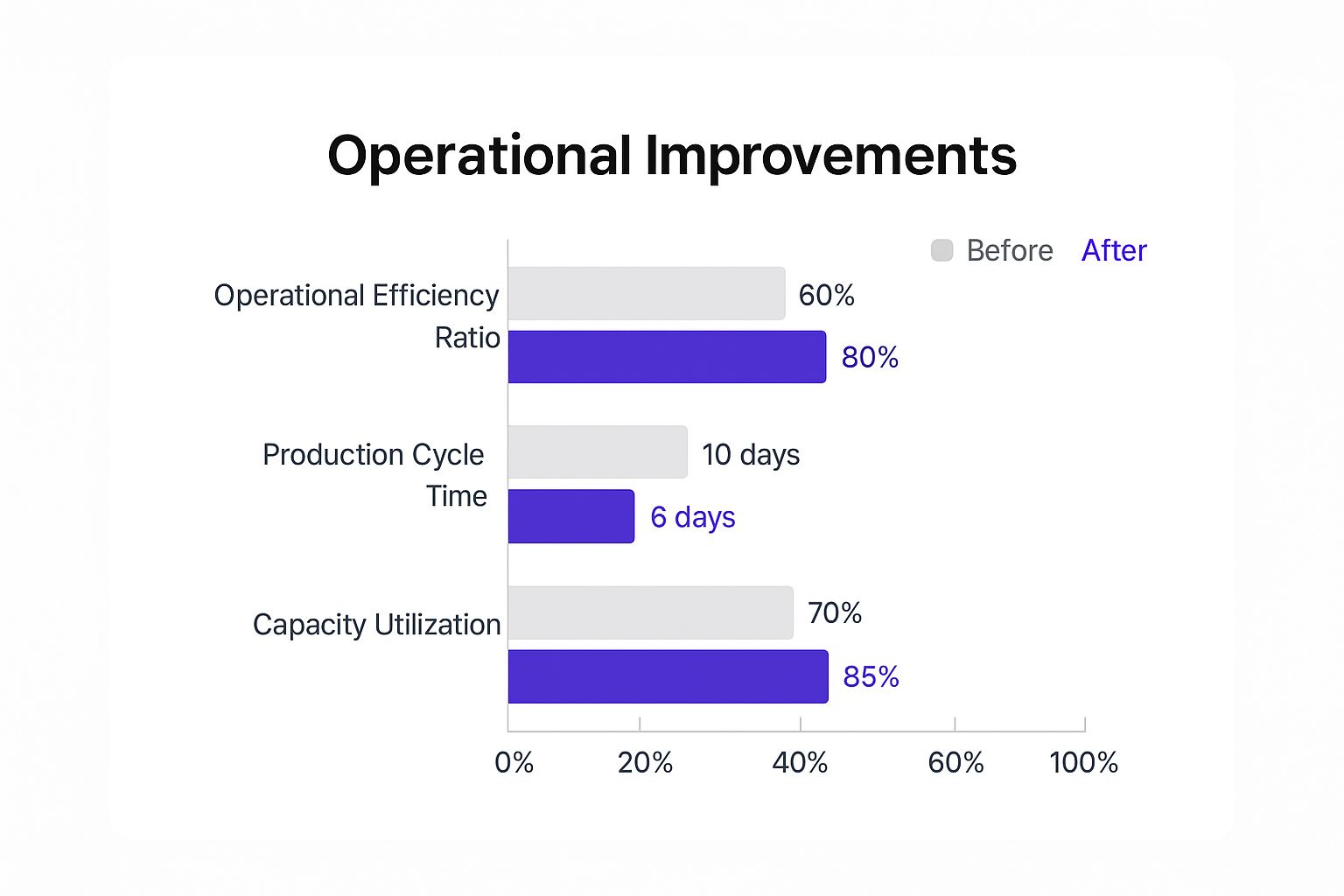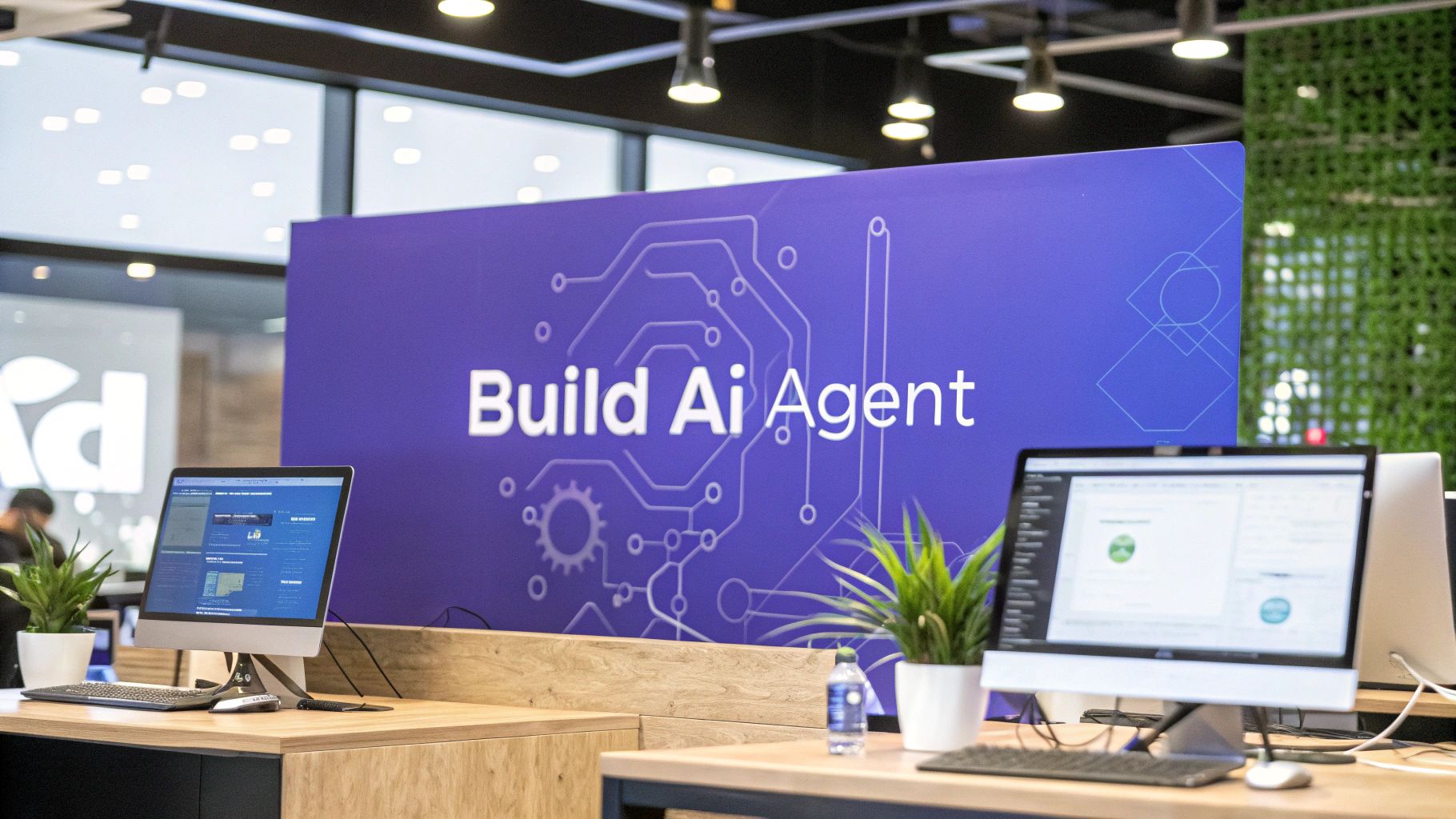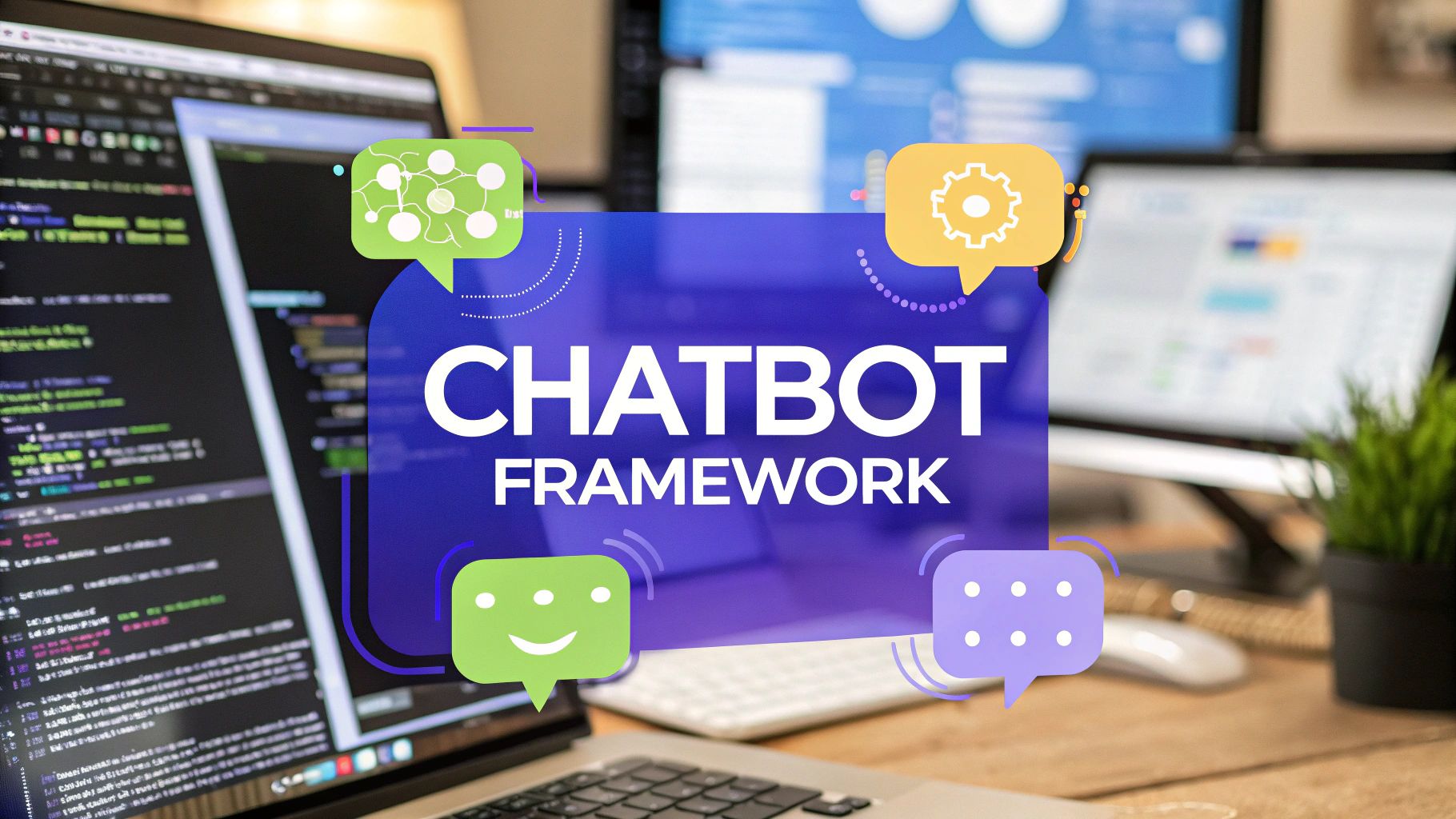Increasing Operational Efficiency for Business Growth
Discover how increasing operational efficiency drives real business growth. Learn practical strategies to streamline workflows and boost productivity.

Increasing operational efficiency means getting more done with the same resources. This isn't about pushing people to work harder. It's about optimizing workflows and cutting out waste so your business runs smoother.
The result is a more profitable, competitive, and less stressful company.
What Is Operational efficiency in Practice?
Imagine a popular coffee shop during its morning rush. One shop has baristas bumping into each other, remaking orders, and struggling to keep up. The second shop has a smooth flow where each person knows their role, and drinks are made correctly the first time.
That second shop is a perfect example of high operational efficiency.
This is not about aggressive cost-cutting. It’s about making work flow better. Real efficiency comes from intelligent workflows, smart resource allocation, and a constant focus on what delivers value to the customer. At its core, it's a simple ratio: the output you produce versus the input you use.

The Core of Efficiency
Operational efficiency is about waging a war on waste. In a business context, "waste" can take many forms. A 2023 study found the average office worker is only productive for about three hours a day, which shows how much time is lost to inefficient tasks.
To get a handle on this, it helps to look at core principles like streamlining business processes. The first step is identifying and eliminating wasteful activities, which can include:
- Wasted Time: Employees waiting for approvals or digging for information.
- Wasted Effort: Reworking mistakes or doing repetitive manual tasks that could be automated.
- Wasted Resources: Overstaffing a project or using expensive software for simple jobs.
When a company is efficient, it becomes more flexible and profitable. Think of it this way: two businesses can be equally productive, but if one operates more efficiently, it's far more likely to be sustainable in the long run.
Why This Matters for Your Business
Improving that output-to-input ratio has a direct and powerful impact. It's not a theoretical concept from business school. Better efficiency leads directly to better profits, happier customers, and less stressed employees.
When you get rid of frustrating bottlenecks and automate mind-numbing work, your team is free to focus on bigger, more important challenges.
The objective behind adopting an operational efficiency mindset is to minimize the time spent on non-value-added activities. By maximizing the focus on value-added work, this approach can significantly improve a company's competitiveness and profitability.
This guide will give you real-world strategies to improve that ratio in your own business, moving from theory to practical application. We’ll look at how to measure where you stand, identify opportunities for improvement, and use modern tools to build a more resilient and successful operation.
Why Prioritizing Operational Efficiency Is a Game Changer
Focusing on operational efficiency changes how your business runs. The payoff hits your bottom line in a few powerful ways: lower operating costs, higher revenue, and happier customers. In today's market, efficiency is what separates the businesses that thrive from those that struggle to keep up.
Think of it like a well-organized assembly line versus a chaotic one. The organized line pumps out more products with fewer mistakes and almost zero waste. That same logic applies to any business process, whether you're handling customer support tickets, pushing invoices through, or shipping new software features.

When things just work, you spend less time and money fixing mistakes or untangling messy workflows. All that freed-up capital can be funneled back into the business, supporting things like product innovation or a bigger marketing push.
The Financial Impact of Efficient Operations
The link between efficiency and financial health is clear. When you cut the waste out of your operations, you can deliver the same quality product or service for less, which directly improves your profit margins. Operationally efficient businesses are also more agile, giving them the ability to pivot and respond to market shifts much faster than their competitors.
That ability to adapt is a massive advantage. For instance, an efficient company can often get new products to market faster or wrap up client projects in record time. This delights customers and carves out a serious competitive edge.
The core financial wins really boil down to this:
- Lower Operating Costs: When you use your resources smarter, you slash expenses tied to labor, materials, and general overhead.
- Higher Revenue Potential: With smooth processes, you can boost your output without increasing costs, opening the door for serious revenue growth.
- Improved Profitability: The combination of lower costs and higher output is a direct route to better company-wide profitability.
By focusing on increasing operational efficiency, businesses can transform their internal structure from a cost center into a source of value. It's about working smarter, not just harder, to build a foundation for long-term financial success.
Research from one study found that 74% of businesses see automating manual tasks as having the most potential to drive process improvement. Automating routine or repetitive tasks allows professionals to spend more time on their core work.
More Than Just Numbers
While the financial perks are huge, the ripple effect of operational efficiency goes much further. It has a big impact on your team’s morale and the entire vibe of your workplace.
When you get rid of frustrating bottlenecks and put repetitive work on autopilot, your employees are free to tackle more engaging, high-value challenges. This simple shift can lead to much higher job satisfaction and lower turnover. A 2023 Microsoft report found that more than 40% of workers were thinking about quitting, often due to burnout and frustration with clunky, inefficient processes.
A well-oiled operation creates a calmer, more predictable work environment where your team can be proactive and strategic instead of constantly putting out fires. They feel more in control and valued, which is a powerful motivator. You can learn more about how this works in our guide to the benefits of workflow automation.
Prioritizing efficiency creates a powerful feedback loop. A more efficient business is a more profitable one, which means you can invest more in your team and your tech. That investment fuels even greater efficiency and growth, making your company more resilient and successful for the long haul.
How to Measure Your Operational Efficiency
You can’t improve what you don’t measure. Before you start rearranging workflows, you need a clear picture of where you stand. Measuring your operational efficiency gives you a baseline, helping you identify weak spots and track your progress as you implement changes.
Think of it like using a map. Without knowing your starting point, it's impossible to chart a course to your destination.
This process involves more than just a gut feeling. It requires using specific Key Performance Indicators (KPIs) to get a hard look at your inputs and outputs. By tracking the right metrics, you move from guesswork to a data-driven strategy. This is a primary step in increasing operational efficiency across your entire business.
Key Metrics You Should Track
Several metrics can help you quantify how well your business is running. While the specific KPIs you choose will depend on your industry and business model, a few are universally helpful for getting a handle on your performance.
- Operational Efficiency Ratio (OER): This is a core financial metric that compares your operational expenses to your net sales. In short, it shows how much it costs you to generate revenue. A lower ratio is always better.
- Production Cycle Time: This measures the total time it takes to complete a process from start to finish. For a software company, that might be the time from a feature request to its deployment. For a manufacturer, it's the time from raw materials to a finished product. Shorter cycle times usually mean greater efficiency.
- Capacity Utilization: This metric shows how much of your total production capacity is actually being used. If your factory can produce 1,000 units a day but is only making 700, your capacity utilization is 70%. A higher rate suggests you're making good use of your available resources.
The goal isn’t just to track numbers but to understand the story they tell. A rising Operational Efficiency Ratio, for example, might signal that your expenses are growing faster than your sales—a clear sign that it’s time to review your processes.
Putting Metrics into Practice
Let's look at a practical example. A digital marketing agency wants to measure its efficiency, so they decide to track their Project Cycle Time. They define this as the time from signing a new client to launching their first campaign.
Initially, they find it takes an average of 30 days. After analyzing the process, they identify bottlenecks in client onboarding and content approval. They introduce a standardized onboarding checklist and a new project management tool to smooth out communication.
Three months later, their average Project Cycle Time drops to just 18 days. That single metric proves their changes are working.
The chart below illustrates how improvements like these can impact key efficiency metrics across the board.

This visualization shows clear gains, demonstrating a successful effort in increasing operational efficiency. The lower cycle time and higher utilization directly contribute to a much healthier efficiency ratio.
Choosing the Right Metrics for Your Business
The most effective KPIs are those that align directly with your business goals. A service-based company will have different priorities than a product-based one, so what works for one won't necessarily work for another. The key is to select a handful of metrics that provide a complete view without overwhelming your team with data.
To help you get started, this table breaks down a few common metrics and shows where they fit best.
Choosing the Right Operational Efficiency Metrics for Your Business
By selecting and consistently monitoring the right KPIs, you can create a clear and actionable path for increasing operational efficiency and driving sustainable growth.
Core Strategies for Boosting Operational Efficiency
Knowing you need to improve is one thing; actually having a solid plan is another. Real gains in operational efficiency don't come from random fixes. They come from a structured approach. The most effective methods usually fall into three main categories.
These pillars are process automation, workflow optimization, and smart technology integration. By focusing on these three areas, you can build a powerful framework for improving efficiency across your entire organization.

Use Process Automation
Process automation is about taking repetitive, manual tasks off your team's plate and letting technology handle them. This frees up your people to focus on work that requires human creativity and strategic thinking, like data entry, generating standard reports, or sending templated email responses.
By 2025, automation has become a central part of any serious efficiency plan. Top companies are using low-code and no-code tools to automate tedious tasks, slashing human error and letting their teams focus on bigger goals. In some cases, automation can cut the time spent on manual data entry by up to 80%, all while making your output more consistent.
The first step is spotting these automation opportunities. Just ask your team: which tasks take up the most time for the least reward? Those are your prime candidates. For some inspiration, check out our detailed guide on business process automation examples.
Optimize Your Workflows
Workflow optimization goes a step beyond just automating individual tasks. It’s about taking a hard look at your entire processes to find and eliminate waste. Methodologies like Lean and Six Sigma might sound complicated, but they’re built on a simple idea: get rid of anything that doesn't add value.
Think about your process for onboarding a new client. Does information get passed smoothly from sales to the project team? Or are there frustrating delays and missing details? An optimized workflow provides a seamless handoff, preventing the kinds of bottlenecks that annoy both your team and your new client.
Here’s how you can start optimizing your own workflows:
- Map Your Current Process: Draw it out from start to finish. This is often the quickest way to spot hidden inefficiencies and pointless loops.
- Identify Waste: Look for delays, redundant steps, or places where mistakes always seem to happen. In the Lean framework, this is known as finding the "muda" (waste).
- Redesign for Flow: Rework the process to be as direct and simple as possible. The goal is a smooth, uninterrupted path from A to B.
This isn't a one-and-done project. Continuous improvement is key. Regularly reviewing and tweaking your workflows makes sure they stay effective as your business evolves.
"Managers plan for near-perfect scenarios but they rarely happen. It’s important to get into the mud with your team and see what’s really going on. Any roadmap for operational efficiency that isn’t based on a granular understanding of current processes is based on rocky foundations."
Integrate the Right Technology
Technology is the engine that powers modern efficiency. The right tools can centralize information, clean up communication, and give you priceless data insights. This is about more than just automation; it's about building a connected tech stack.
Project management tools like Asana or Jira bring clarity to complex projects, while communication platforms like Slack can cut down on slow, clunky email chains. And more advanced tools, like Chatiant's AI agents, can handle complex customer interactions or internal support queries, delivering instant answers and freeing up your team for high-value work.
A well-integrated tech stack breaks down departmental silos and creates a single source of truth. That means less time spent hunting for information and more time spent making smart decisions.
Departmental Automation Opportunities
To make this more practical, let’s look at some common tasks across different departments that are perfect for automation. Targeting these low-hanging fruit can deliver quick wins and build momentum for bigger efficiency drives.
By strategically applying these core strategies, you can systematically remove friction from your day-to-day operations. The result is a more resilient, agile, and profitable business that's ready for whatever comes next.
The Role of AI in Modern Operations
Artificial intelligence is changing how businesses get work done, moving far beyond basic automation. AI tools, like Chatiant, are becoming central to increasing operational efficiency by tackling complex tasks that once demanded constant human oversight. This shift allows teams to move their attention from routine fire-fighting to high-value strategic work.
Think about it: an AI agent can manage customer questions around the clock. It can handle detailed product inquiries, check order statuses, and even troubleshoot common issues without ever needing a break. This does not just cut down on customer wait times; it frees up human agents to manage the sensitive or complex interactions that truly need a personal touch.
The result is a more responsive and cost-effective support system. Lower support costs, faster resolutions, and a better customer experience are all direct outcomes of weaving intelligent AI into your day-to-day operations.
AI as an Analytical Powerhouse
Beyond customer-facing roles, AI is an incredibly powerful analytical tool. It can dig through enormous amounts of operational data to spot inefficiencies and bottlenecks that a human manager might easily miss. This gives leaders a clear, data-backed view of exactly where their processes are breaking down.
For example, an AI could analyze project timelines and resource allocation data to pinpoint which stages consistently cause delays. Are teams waiting too long for approvals? Is one department always stretched thin? AI can answer these questions with precision, offering actionable insights for continuous improvement.
This analytical strength turns operational management from a reactive practice into a proactive one. Instead of just putting out fires, you can prevent them from starting. For more ideas on improving your processes, you can learn more about how to optimize your workflow in our detailed guide.
Practical AI Application: A Case Study
Let's look at a practical example. A busy healthcare clinic wants to reduce the administrative burden on its front desk staff, who spend hours each day scheduling appointments and answering the same patient questions over and over.
They decide to implement a Chatiant AI agent on their website and internal messaging platform.
- Appointment Scheduling: The AI agent integrates directly with the clinic's calendar. Patients can now book, reschedule, or cancel appointments through the chatbot, which automatically finds available slots and sends confirmations.
- Answering FAQs: The bot is trained on the clinic's data to answer common questions like, "What are your hours?" or "Do you accept my insurance?" This provides instant answers to patients and immediately reduces call volumes.
The real impact is measured in outcomes. The clinic sees a 40% reduction in administrative phone calls, allowing staff to focus on in-person patient care. Patient satisfaction scores also improve thanks to the convenience of 24/7 self-service.
This is a clear-cut demonstration of AI's role in increasing operational efficiency. It automates a high-volume, low-complexity workflow, delivering tangible benefits for both the business and its customers.
The Broader Impact on Productivity and People
Integrating AI into daily operations does more than just make processes faster. It also has a significant, positive effect on the workforce. When tedious, repetitive tasks are automated, employees can concentrate on more engaging and creative work, which boosts both their productivity and job satisfaction.
Recent data highlights this trend clearly. Companies using AI report higher productivity (72%) and improved job satisfaction (59%). Better yet, about 75% of knowledge workers say AI tools help them save time and feel more creative. This shows AI is a real benefit for the team, too.
Navigating the Challenges of Digital Transformation
Putting new systems and processes in place is rarely a simple task. While the goal is always increasing operational efficiency, the path to get there is often filled with hurdles. Businesses frequently run into the same obstacles when they introduce digital tools, from employee pushback to technical integration headaches. A successful transformation requires just as much focus on people and strategy as it does on the technology itself.
The reality is that these projects are complicated. Global spending on digital transformation is expected to hit nearly $4 trillion by 2025, yet a staggering 35% of these initiatives actually achieve their goals. A huge part of the problem comes from the difficulty of integrating new technology with older systems and, just as importantly, getting teams to adapt.
Overcoming Employee Resistance
One of the biggest hurdles isn’t technical—it’s human nature. People get comfortable with existing workflows, and the idea of learning a new system can feel disruptive. This resistance isn’t about defiance; it’s usually rooted in a fear of the unknown or a concern that the new tools will make their jobs harder, not easier.
To get past this, clear communication is everything. Instead of just announcing a new tool, you have to explain the "why" behind it. Show your team how it will reduce frustrating tasks and free them up for more meaningful work.
Here are a few practical steps:
- Create a Clear Communication Plan: Regularly share updates on the transformation process, including timelines, goals, and expected benefits. No one likes being left in the dark.
- Provide Solid Training: Offer hands-on training sessions and easy-to-access resources so everyone feels confident using the new systems.
- Start with Small Pilot Projects: Roll out the new technology to a single team or department first. A small, successful pilot project serves as a powerful proof of concept and builds momentum for the bigger launch.
The Data Governance Hurdle
Another massive challenge is managing data. As you introduce new digital tools, you generate more data, which needs to be accurate, secure, and accessible. Without a solid data governance plan, you risk creating information silos and making critical decisions based on faulty information.
This is a huge barrier to scaling AI, with 62–65% of data leaders now seeing governance as their biggest impediment. You can find more insights on these data transformation challenges at Integrate.io.
Successfully managing a digital transformation means looking beyond the software. It’s about leading your people through change, making sure your technology plays well together, and building a solid data foundation for the future.
By anticipating these common challenges and planning for them, you can steer your digital transformation toward success. Addressing the people, process, and data aspects from the start turns a potentially rocky transition into a smooth and effective step forward in increasing operational efficiency.
Frequently Asked Questions
Where Should I Start Improving Operational Efficiency?
The best place to start is usually wherever the biggest headaches are. Look for the most obvious bottlenecks or the mind-numbing, repetitive tasks that eat up your team's day. A quick process audit will often point you right to the problem areas.
Not sure where that is? Just ask your team. They’ll know exactly which tasks take up the most time for the least reward. Things like manual data entry, customer support backlogs, or compiling internal reports are often prime candidates. A small win here can build serious momentum.
How Can a Small Business Improve Efficiency on a Budget?
You don’t need a huge budget to start making things run better. Plenty of free or low-cost tools can make a real difference. The first step is often just mapping out your current processes on a whiteboard to see where things get messy.
Free project management tools like Trello or Asana are great for getting work organized and making sure everyone is on the same page. You can also automate simple, repetitive tasks with tools like Zapier, which has free plans to get you started. The key is to fix the process first, before you throw a bunch of money at new technology.
How Do I Get My Team to Adopt New Processes?
Getting your team on board is everything. If they don't buy in, even the best process will fail. Start by explaining the "why" behind the change—show them how it will cut down on their frustration and free them up to do more meaningful work.
Even better, bring them into the redesign process. They’re the experts on their own daily workflows, and their feedback is invaluable. Finally, make sure you provide solid training and support during the transition. When people feel confident and supported, they're much more likely to embrace the change.
Ready to take the next step in increasing operational efficiency? Chatiant’s AI agents can automate customer support, streamline internal workflows, and free up your team for high-value work. Learn more and get started today at Chatiant.com.


